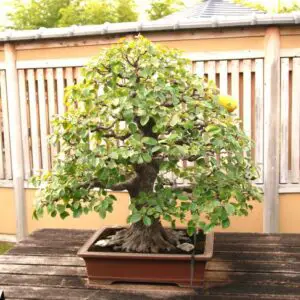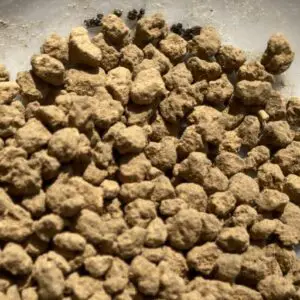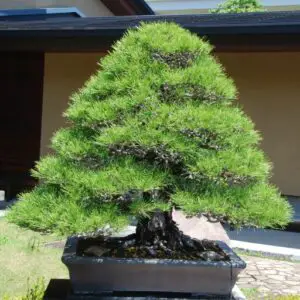You need to repot your bonsai tree if you see signs of roots becoming pot-bound, soil deteriorating in its quality or it has been a few years since the last repotting.
Signs that your bonsai tree needs repotting
Regular repotting is an important aspect of bonsai care to help ensure the longevity, health, and beauty of your tree. But it is not always obvious when to repot it. It is different from ordinary houseplants as bonsai trees are grown in shallow pots with a bare amount of soil.
Bonsai trees should be repotted when:
- their roots are pot-bound,
- the soil has degraded, and
- a few years have passed since repotted last.
How to tell root-bound bonsai

Chinese quince
There are 2 ways to tell if your bonsai tree is root-bound; one is to test the tree on the spot and the other is a continuous observation of the tree.
Root-bound test
Tease the tree
One way to test your bonsai tree for root-bound is to tease the tree.
Grab the bottom of the trunk and tease it very gently. If the tree is clinging to the sides and bottom of the pot, it may be a sign that it is root-bound. Be careful if you wired your tree to the pot when you last repotted. In this case, the tree may not loosen up unless you cut the wire.
I do not recommend pulling your tree out of the pot to check the root system directly. Though it can be a definitive test, removing the tree from the pot is a very stressful process for the tree and can disturb the root system by stretching or tearing it off.
It is best to use other methods to determine if the bonsai tree is root-bound before resorting to this process.
Press on the soil
Another way is to press on the surface of the soil with your finger.
If the soil feels really firm and does not give when you press on it, it may be a sign that the roots are tightly packed and the tree is root-bound.
Observe the tree
Familiarize yourself with the signs and symptoms of root-bound bonsai and observe your tree well. The common symptoms of root-bound bonsai include:
- slow drainage,
- less visible soil than before,
- elevated tree (soil),
- visible roots, and
- stunted growth, wilting, and yellowing leaves.
If many of them fit, your tree may be root-bound. Keep in mind that this observation takes time: you need to observe the tree every day and look for change, especially during the growing season.
This is because the symptoms on trees, such as wilting and yellowing leaves, cannot be seen during winter for deciduous trees. Slow drainage and an elevated tree can be from frozen soil. In winter, coniferous trees also show similar symptoms that may be caused by cold damage and not by root-bound.
So, it is important to observe the tree when you take care of it to look for signs of change in its health and environment.
If you are interested to know more about root-bound bonsai, please check the following post.
How to tell soil degradation

Akadama
Visible test
The structure of the soil is not permanent and degrades over time depending on the type of soil, environment and vegetation.
There are a few signs that can indicate soil degradation in a bonsai tree, including:
- The soil appears to be breaking down, becoming crumbly, and looking silky;
- The soil appears to be compacted; and,
- Water does not drain through the soil as quickly as before.
Soil degradation may manifest in your tree’s condition such as slow growth and yellowing leaves.
Soil lifespan
It can be difficult to determine if bonsai soil is degraded simply by observing the soil and the tree because deterioration of soil quality, nutrient depletion, and organic matter breakdown are difficult to determine by look alone.
This is why it is better to repot regularly to change the soil. The lifespan of common soil used for bonsai is as follows:
-
- Akadama/Kamuma soil mix: 2-3 years
- Lava rock/pumice mix: 3-5 years
For more about lifespan and degradation of soil, the following post might be helpful.
How often bonsai trees needs to be repotted

Japanese white pine bonsai
Bonsai trees should be repotted every 1 to 4 years depending on their species and age.
-
- Deciduous/ flower/fruit trees: every 1-2 years
- Coniferous trees: every 3-4 years
Factors affecting the repotting frequency
There are a few factors that affect the frequency of repotting bonsai trees, which are the causes of root-bound and soil degradation.
The factors affecting the frequency of repotting bonsai trees include:
Species of the tree
Different species of trees have different growth rates and root systems, which affect how often they need to be repotted. Generally speaking, coniferous trees grow much slower than deciduous trees.
Age of the tree
Younger trees grow faster and require more frequent repotting, while older trees need repotting less often.
Growth rate of the tree
Even among the same species, the growth rate may differ from one tree to another. Trees that grow quickly need more frequent repotting.
Size of the pot
Trees in smaller pots (even as bonsai trees) become root-bound more quickly and need more frequent repotting than in larger pots.
Type of soil used
Generally speaking, Akadama has a shorter lifespan than lava rock. Lower-quality soil tends to degrade much faster than higher-quality ones.
Climate and environmental conditions
Trees in hotter or drier climates may need more frequent watering, which can lead to soil degradation and the need for more frequent repotting. High temperatures and repeated freezing and thawing can make the soil erode faster.
When to check if your bonsai tree needs repotting

Japanese black pine bonsai
The best time to check if your bonsai tree needs repotting is in the early spring when the tree is still dormant, just before new growth starts. Apart from a few exceptions, repotting of bonsai trees can only be done at this time of the year.
If you miss this window, it can be difficult to repot bonsai trees without risking their health. So, you need to constantly observe your bonsai tree year-round if it is doing well to consider if it needs repotting the next spring.
If you notice anything wrong, determine the cause. The signs and symptoms of root-bound tree and soil degradation may be induced by pests, diseases, root rot or extreme weather conditions.
It is also important to note that not all bonsai trees will show the same signs of needing repotting. Some trees may show clear signs of being root-bound or have visible roots growing out of the pot, while others may show more subtle signs like slow growth or yellowing leaves.
This is why it is important to check your bonsai tree regularly, even if it appears to be healthy on the surface.



